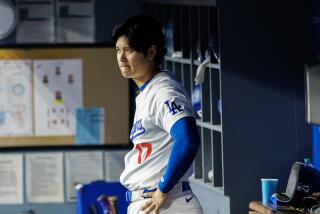L.A.’s gold medal event is still a winner 25 years later
- Share via
Unheralded, a ribbon of aqua runs along the outside rim of the Los Angeles Memorial Coliseum. Down the street, on the side of a neighborhood recreation center, rests a set of Olympic rings.
Both are reminders of the city’s last Olympics, the 1984 games, which got underway 25 years ago this past week. The aqua and its accompanying violet slash were part of the riotous, tropical color scheme in which the Olympic venues were doused, most dramatically the solid old Coliseum, home to opening and closing ceremonies and track events.
The rings are the very ones lighted by Rafer Johnson to open the Games. The 1960 decathlon champion had sprinted up 99 Coliseum steps with his flaming torch and, holding it aloft, sent fire billowing through the rings and up into the caldron atop the stadium. When the Games ended, the rings were warehoused until installed down the block.
The Los Angeles Games were Olympics on the cheap. Unlike the recent Beijing celebration, replete with newly constructed stadiums and architecturally stunning venues, Los Angeles’ 1984 effort rested on the shoulders of things already here, including the Coliseum. When the Olympics ended, there were few locales to remind us explicitly of the event; most slid back into the fabric of Southern California, back to their former lives.
But a 25-year-old paint job and the often-overlooked rings are not the Olympics’ sole legacy.
The very things that made the Los Angeles Games financially sound -- among them the refusal by organizers to build enormously expensive sites -- allowed a startling $232-million surplus. Of that, $93 million was promised to youth sports in Southern California, with the expectation that the money would run out within 20 years.
Five years past that date, the money is still coming.
So far, $185 million -- proceeds of the investment of the original sum -- has been handed out to about 1,000 groups. At least 2 million kids have been helped. Fifty thousand coaches have been taught skills, to be passed on to additional thousands. A generation of volunteerism has been fed.
And still the money comes, at a clip of about $8 million a year. Officials at the LA84 Foundation now believe the giving can be sustained forever.
“It’s the legacy that keeps on giving,” said the foundation’s president, Anita DeFrantz.
The premise of the donations to local sports groups is simple: Skills taught in athletics -- teamwork, discipline, focus -- will spread into the rest of a child’s life, even if interest in basketball or soccer or volleyball wanes. The targets are children in poorer locations for whom organized sports often are unaffordable or unavailable. Most of the money goes to groups in Los Angeles County, because it bore the brunt of the disruptions associated with the Games.
This year alone, the foundation gave almost $550,000 to after-school programs at 85 L.A. Unified middle schools and $250,000 for sports programs at 180 elementary schools. It gave $50,000 to Santa Ana’s swim program; $150,000 to train high schoolers to run in the Los Angeles Marathon; $56,000 for a new baseball field for the Los Angeles Boys and Girls Clubs; $50,000 for kids in the Pico Union district; $40,000 for soccer players in Compton, Pomona and Anaheim. And on and on.
One of the chief recipients has been Kids in Sports, which spun off from the Olympic foundation in the mid-1990s. It sponsors 15 sports clubs, arranged around Los Angeles County schools or housing projects, that provide basketball, soccer, volleyball, baseball and other activities.
This year 8,000 kids, ages 5 to 17, will take part. The organization pays for equipment, uniforms and officiating. The 700 volunteers do the rest.
For those they serve, “there are no other options in terms of sports programs,” said Elva Sandoval, the group’s executive director. “The need is there because the options aren’t.”
The Olympic foundation’s $450,000 grant this year amounts to a little less than half the organization’s budget, which is aided by other foundations and individuals. It has felt the pain of the economic downturn, but it is hanging on.
Like many who work in the LA84 Foundation, Patrick Escobar is an Olympics veteran. He joined the Los Angeles committee in 1980, when there were only about 70 employees for an enterprise that would end up with 1,750 paid workers and 70,000 volunteers. Although he recalls the Olympics as “pressure-packed and hard,” he believes they meant far more than that to Southern California.
“It sounds corny, but there was a little bit of a magical time,” said Escobar, now LA84’s vice president for grants and programs. “It was a magical time in the city which has not, in my mind, been duplicated since.”
Funny things happen with magic. The colorful paint on the Coliseum was supposed to fade quickly; fellow Olympics veteran DeFrantz remembers conversations in early 1984 about timing the painting so it would last through the Games.
And yet that paint is still there 25 years later, a visible reminder, as is the money that flows to children not yet born when the Olympic flame last burned here.
“It’s safe to say,” said Escobar, “that we’ve exceeded everyone’s expectations.”
cathleen.decker @latimes.com.
Each Sunday, The Week examines implications of major stories. It is archived at latimes.com/theweek.
More to Read
Sign up for Essential California
The most important California stories and recommendations in your inbox every morning.
You may occasionally receive promotional content from the Los Angeles Times.











